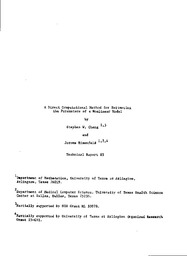| dc.contributor.author | Eisenfeld, Jerome | en |
| dc.contributor.author | Cheng, Stephen W. | en |
| dc.date.accessioned | 2010-06-04T14:32:51Z | en |
| dc.date.available | 2010-06-04T14:32:51Z | en |
| dc.date.issued | 1978 | en |
| dc.identifier.uri | http://hdl.handle.net/10106/2366 | en |
| dc.description.abstract | **Please note that the full text is embargoed** ABSTRACT: We consider the system identification problem which deals with determining information about the unknown constant matrices A, B, and C or the linear dynamical system: [see pdf for notation], where u(t) and y(t) are given discretely on the interval [0,T]. This leads to a nonlinear estimation problem, or a so-called deconvolution problem, which deals with estimating the number of components [see pdf for notation], the decay rates [see pdf for notation], and the corresponding amplitudes [see pdf for notation] in the model: [see pdf for notation] from the given discrete data [see pdf for notation]. Deconvolution problems are important in a number of fields. One of these is the analysis of fluorescence decay experimental data [3]. Many numerical methods are available for approaching this problem.
The Isenberg method of moments (or IMOM for short) was found to be the best among these methods in most cases [2]-[7]. A direct computational method which is essentially based on the general moment theory has been developed [7]. This method which was called the direct computational method (or DCM for short) alleviates some long standing difficulties arising from IMOM. Two of these are the cut-off error incurred when integration is required to infinite time and lack of flexibility in weighting the data.
In this paper, the theory is presented with the specification of the admissible weighting functions and the estimation of the amplitudes [see pdf for notation]. using the linear least squares method as an option. The filtering
scheme, which can be used to filter out one known decay term and increase
the accuracy of the estimation, is presented. Numerical examples are provided. | en |
| dc.language.iso | en_US | en |
| dc.publisher | University of Texas at Arlington | en |
| dc.relation.ispartofseries | Technical Report;85 | en |
| dc.subject | Deconvolution problems | en |
| dc.subject | Isenberg method of moments | en |
| dc.subject | Direct computational method | en |
| dc.subject | System identification | en |
| dc.subject.lcsh | Nonlinear estimation problems | en |
| dc.subject.lcsh | Mathematics Research | en |
| dc.title | A Direct Computational Method for Estimating the Parameters of a Nonlinear Model | en |
| dc.type | Technical Report | en |
| dc.publisher.department | Department of Mathematics | en |

